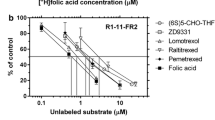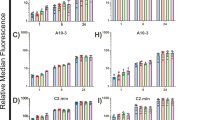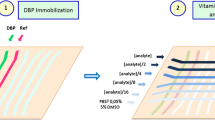Abstract
Purpose
Using in vitro competition assays, determine salient chemical features of pteroates and pteroate-drug conjugates which afford high affinity to the folate receptor.
Materials and Methods
Both folate binding protein-coated polystyrene plates and adherent human cell-based assays were used to evaluate the effects of assay temperature and buffer composition on pteroate/pteroate-drug conjugate binding affinity. Following assay selection and optimization, the relative binding affinities of ten vitamers and derivatives as well as seven pteroate-drug conjugates were evaluated.
Results
Compared to polystyrene plates containing immobilized folate binding protein, adherent KB cells were determined to be an equally effective, more desirable source of folate receptor for such analyses. Using the latter method, we discovered that a charged group positioned in close proximity to the pteroate’s aryl moiety is critical for retaining high binding affinity. We also found that a diverse set of bioactive small molecule agents can be attached to folic acid in a manner that does not appreciably disturb this vitamin’s intrinsic high affinity for the folate receptor. However, conjugation of lipophilic, high protein-binding agents to folate was sometimes found to dramatically reduce affinity, which is a finding that best exemplifies the need for having a reliable in vitro assay for determining a compound’s RA.
Conclusion
Molecules which bind best to the human folate receptor are those that contain hydrophilic regions distal to the ligand’s aryl group, and for drug conjugates, an extended hydrophilic spacer placed in-between the pteroate and drug cargo moieties.





Similar content being viewed by others
References
C. P. Leamon, and P. S. Low. Delivery of macromolecules into living cells: a method that exploits folate receptor endocytosis. Proc. Natl. Acad. Sci., USA. 88:5572–5576 (1991) doi:10.1073/pnas.88.13.5572.
C. P. Leamon, and P. S. Low. Membrane folate-binding proteins are responsible for folate- protein conjugate endocytosis into cultured cells. Biochem. J. 291:855–860 (1993).
I. G. Campbell, T. A. Jones, W. D. Foulkes, and J. Trowsdale. Folate-binding protein is a marker for ovarian cancer. Cancer Res. 51:5329–5338 (1991).
C. P. Leamon, and J. A. Reddy. Folate-targeted chemotherapy. Adv. Drug Deliv. Rev. 56:1127–1141 (2004) doi:10.1016/j.addr.2004.01.008.
J. A. Reddy, R. Dorton, E. Westrick, A. Dawson, T. Smith, L. C. Xu, M. Vetzel, P. Kleindl, I. R. Vlahov, and C. P. Leamon. Preclinical evaluation of EC145, a folate-Vinca alkaloid conjugate. Cancer Res. 67:4434–4442 (2007) doi:10.1158/0008-5472.CAN-07-0033.
C. P. Leamon, J. A. Reddy, I. R. Vlahov, E. Westrick, A. Dawson, R. Dorton, M. Vetzel, H. K. Santhapuram, and Y. Wang. Preclinical antitumor activity of a novel folate-targeted dual drug conjugate. Mol. Pharm. 4:659–667 (2007) doi:10.1021/mp070049c.
P. S. Low, and A. C. Antony. Folate receptor-targeted drugs for cancer and inflammatory diseases. Adv. Drug Deliv. Rev. 56:1055–1238 (2004) doi:10.1016/j.addr.2004.02.003.
L. Xu, I. R. Vlahov, C. P. Leamon, H. K. R. Santhapuram, and C. H. Li. Synthesis, purification, and uses of pteroic acid and derivatives and conjugates thereof. Patent application number PCT/US2006/009153, filed March 14, 2006 (2005).
C. P. Leamon, M. A. Parker, I. R. Vlahov, L. C. Xu, J. A. Reddy, M. Vetzel, and N. Douglas. Synthesis and biological evaluation of EC20: a new folate-derived 99mTc-based radiopharmaceutical. Bioconjug. Chem. 13:1200–1210 (2002) doi:10.1021/bc0200430.
Y. Lu, and P. S. Low. Folate targeting of haptens to cancer cell surfaces mediates immunotherapy of syngeneic murine tumors. Cancer Immunol. Immunother. 51:153–162 (2002) doi:10.1007/s00262-002-0266-6.
C. P. Leamon, J. A. Reddy, I. R. Vlahov, M. Vetzel, N. Parker, J. S. Nicoson, L. C. Xu, and E. Westrick. Synthesis and biological evaluation of EC72: a new folate-targeted chemotherapeutic. Bioconjug. Chem. 16:803–811 (2005) doi:10.1021/bc049709b.
C. P. Leamon, J. A. Reddy, I. R. Vlahov, P. J. Kleindl, M. Vetzel, and E. Westrick. Synthesis and biological evaluation of EC140: a novel folate-targeted Vinca alkaloid conjugate. Bioconjug. Chem. 17:1226–1232 (2006) doi:10.1021/bc060145g.
I. R. Vlahov, H. K. Santhapuram, P. J. Kleindl, S. J. Howard, K. M. Stanford, and C. P. Leamon. Design and regioselective synthesis of a new generation of targeted chemotherapeutics. Part 1: EC145, a folic acid conjugate of desacetylvinblastine monohydrazide. Bioorg. Med. Chem. Lett. 16:5093–5096 (2006) doi:10.1016/j.bmcl.2006.07.030.
T. R. Jones, A. H. Calvert, A. L. Jackman, S. J. Brown, M. Jones, and K. R. Harrap. A potent antitumour quinazoline inhibitor of thymidylate synthetase: synthesis, biological properties and therapeutic results in mice. Eur. J. Cancer. 17:11–19 (1981) doi:10.1016/0014-2964(81)90206-1.
T. R. Jones, M. J. Smithers, R. F. Betteridge, M. A. Taylor, A. L. Jackman, A. H. Calvert, L. C. Davies, and K. R. Harrap. Quinazoline antifolates inhibiting thymidylate synthase: variation of the amino acid. J. Med. Chem. 29:1114–1118 (1986) doi:10.1021/jm00156a033.
G. R. Westerhof, J. H. Schornagel, I. Kathmann, A. L. Jackman, A. Rosowsky, R. A. Forsch, J. B. Hynes, F. T. Boyle, G. J. Peters, H. M. Pinedo, and G. Jansen. Carrier- and receptor-mediated transport of folate antagonists targeting folate-dependent enzymes: correlates of molecular structure and biological activity. Mol. Pharm. 48:459–471 (1995).
C. P. Leamon, J. A. Reddy, I. R. Vlahov, E. Westrick, N. Parker, J. S. Nicoson, and M. Vetzel. Comparative preclinical activity of the folate-targeted Vinca alkaloid conjugates EC140 and EC145. Int. J. Cancer. 121:1585–1592 (2007) doi:10.1002/ijc.22853.
M. McHugh, and Y. C. Cheng. Demonstration of a high affinity folate binder in human cell membranes and its characterization in cultured human KB cells. J. Biol. Chem. 254:11312–11318 (1979).
B. A. Kamen, and A. Capdevila. Receptor-mediated folate accumulation is regulated by the cellular folate content. Proc. Natl. Acad. Sci. U. S. A. 83:5983–5987 (1986) doi:10.1073/pnas.83.16.5983.
A. C. Antony, M. A. Kane, R. M. Portillo, P. C. Elwood, and J. F. Kolhouse. Studies of the role of a particulate folate-binding protein in the uptake of 5-methyltetrahydrofolate by cultured human KB cells. JBC. 260:14911–14917 (1985).
C. P. Leamon, R. B. DePrince, and R. W. Hendren. Folate-mediated drug delivery: effect of alternative conjugation chemistry. J. Drug Target. 7:157–169 (1999).
E. Sadasivan, and S. P. Rothenberg. The complete amino acid sequence of a human folate binding protein from KB cells determined from the cDNA. J. Biol. Chem. 264:5806–5811 (1989).
G. R. Westerhof, S. Rijnboutt, J. H. Schornagel, H. M. Pinedo, G. J. Peters, and G. Jansen. Functional activity of the reduced folate carrier in KB, MA104, and IGROV-I cells expressing folate-binding protein. Cancer Res. 55:3795–3802 (1995).
T. P. McAlinden, J. B. Hynes, S. A. Patil, G. R. Westerhof, G. Jansen, J. H. Schornagel, S. S. Kerwar, and J. H. Freisheim. Synthesis and biological evaluation of a fluorescent analogue of folic acid. Biochemistry. 30:5674–5681 (1991) doi:10.1021/bi00237a006.
G. R. Westerhof, G. Jansen, T. P. McAlinden, J. H. Schornagel, J. B. Hynes, and J. H. Freisheim. A photoaffinity analogue of folic acid as a probe for the identification and function of a membrane folate binding protein (mFBP) in human CCRF-CEM leukemia cells. Proc. Am. Assoc. Cancer Res. 32:328 (1991).
Acknowledgements
The authors wish to thank Marilynn Vetzel for providing the numerous plates of adherent KB cells throughout this investigation.
Author information
Authors and Affiliations
Corresponding author
Rights and permissions
About this article
Cite this article
Leamon, C.P., You, F., Santhapuram, H.K. et al. Properties Influencing the Relative Binding Affinity of Pteroate Derivatives and Drug Conjugates Thereof to the Folate Receptor. Pharm Res 26, 1315–1323 (2009). https://doi.org/10.1007/s11095-009-9840-3
Received:
Accepted:
Published:
Issue Date:
DOI: https://doi.org/10.1007/s11095-009-9840-3




